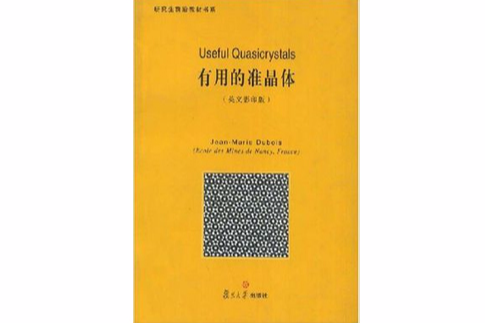《研究生前沿教材書系·有用的準晶體》是2006年11月1日復旦大學出版社出版的圖書,作者是(法國)Jean-Marie Dubois。
基本介紹
- 書名:研究生前沿教材書系·有用的準晶體
- 作者:(法國)Jean-Marie Dubois
- 原版名稱:Useful Quasicrystals
- ISBN:7309052080
- 頁數:482頁
- 出版社:復旦大學出版社
- 出版時間:2006年11月1日
- 裝幀:平裝
- 開本:16
- 版次:第一版
- 條形碼:9787309052084
- 叢書名:研究生前沿教材書系
- 正文語種:英語
- 尺寸:22.4 x 15.4 x 2.6 cm
- 重量:699 g
內容簡介,作者簡介,目錄,
內容簡介
20世紀80年代研究發現,合金的組分金屬如果嚴格按黃金比值配比的話,如Al65 Cu20 F15 ,那么從液態逐步冷卻到固態過程中就會產生穩定的準晶體。準晶體完全不同於嚴格的金屬晶體和玻璃體,它具有自身奇特的性質,因此具有廣闊的套用前景。《有用的準晶體》就是作者在總結研究前沿的套用成果的基礎上寫成的。全書共分五章:第一章主要講述準晶體同晶體和玻璃體的區別;第二、第三章分別介紹準晶體的電子特性和原子遷移本領,熱輸運和表面特性分別是兩章的講述重點。這兩章的主要論點在於闡釋準晶體的奇異特性無法用金屬理論和合金理論解釋的原因。第四章主要介紹準晶體的相形變、樣品的製備和規模生產的途徑。第五章集中講述準晶體的現有套用和潛在的套用前景。
序言之後及各章末尾都列出參考文獻,為讀者希望深入研究提供幫助。全書末尾,作者在“結束語——美夢還未成真”中,概括了準晶體的研究歷史和現狀,明確了未來的研究方向,對讀者具有很好的指導作用。
作者簡介
作者:(法國)Jean-Marie Dubois
Jean-Marie Dubois
1950年出生於法國Nancy市,物理學博士,法國國家科研中心(CNRS)傑出研究導師兼Jean Lamour研究所所長。
從1978年至2005年培養了20位博士,並擔任下述機構的負責人:
①複雜金屬合金歐洲合作中心(涉及12個國家19個團體中的255位科學家和80位博士組成的研究集團)總主持;②Jean Lamour研究所關於材料-冶金-納米科學-電漿-表面科學課題組的基金和建築規劃項目的負責人;③準晶體研發的Brite-Euram項目的協調人;④Nancy材料科學和工程實驗室主任;⑤Nancy材料工程中心的科學主任;⑥法國準晶體和複雜合金重點項目課題組組長(涉及法國30個實驗室的130位科學家的研究項目)。
主要著作有:發表學術論文300餘篇,著作5本,14項專利,內容涉及固體物理、材料科學和套用,準晶態材料和複雜金屬合金的套用等。在國際學術會議上報告100餘次。
主要成就為:適用於金屬-準金屬玻璃相變原子結構的化學孿晶模型(1980年至1982年);鋁-基金屬玻璃的發現(1982年專利);根據中子衍射數據最先建立Al-Mn準晶體的結晶模型(1986年);Al-Cu-Fe合金中液體-準晶體可逆轉變的最先在位研究(1986年);準晶體潛在套用的頭一個專利(1988年);準晶體低熱導率的研究(1991年專利);最先提出工業規模製造準晶體的構想(1992年至1994年);複雜金屬合金中電子態的偏分密度的系統研究(1994年至今);複雜金屬合金的浸潤及摩擦特性的實驗和理論研究;複雜金屬合金低摩擦特性在真空技術和航空技術中的套用(2001年至今)等。
主要的榮譽有:英國劍橋大學Churchill學院會員,法國冶金和材料學會頒發的Jean Rist獎,法國國家科研中心授予的銅質獎章,IBM材料科學獎,大連技術大學終身邀請教授,清華大學海外專家友誼獎,法國物理學會Yves Rocard獎,等等。
目錄
TABLE of CONTENTS
Foreword The Golden Mean and the Kitchen
General References
Chapter 1 What to Know to Start with
1 Introduction
2 Classical and Non-Classical Crystals
3 The Reciprocal Space
4 The Search for Enhanced Mechanical Properties
5 The Birth of a Monster
6 The Quarrel of Ancients and Modems
7 The World of Quasicrystals
8 Recovering the Periodicity
9 Organised Disorder: the Phasons
10 From Tilings to Coverings
References
Chapter 2 Strange Physical Properties
1 Introduction
2 Basics of Metal Physics, in Very Simple Words
2.1 Electron Transport in Metallic Crystals
2.2 Electron Bands
2.3 The Hume-Rothery Rules in Crystals
3 Electronic Transport in Quasicrystals
3.1 Phenomenological Data
3.2 An Insulator Made of Metals
3.3 Quantum Interference Effects
3.4 Variable Range Hopping
3.5 Hierarchical Recurrent Localization
3.6 Optical Properties
3.7 Another Step Towards a Model of Electronic Conductivity
4 Electron Densities of States
4.1 Pseudogap and Relevant Experimental Information
4.2 The Hume-Rothery Gap in Related Crystals
4.3 Surface Electronic States
4.4 A Bit More about d-states and the Role of Transition Metals
4.5 Enhanced Stability of Quasicrystals and Approximants
5 Lattice Dynamics and Thermal Conductivity
5.1 Lattice Vibrations in Icosahedral Mono-Domain Samples
5.2 Heat Conduction
5.3 Structural Scattering of Phonons
5.4 Electronic Contribution to Heat Transport
6 Magnetism
References
Chapter 3 When Atoms Move Away
1 Introduction
2 Brittle Intermetallics that End into Chewing-Gum
2.1 Hardness, Brittleness and Low Friction
2.2 Plastic Behaviour at Elevated Temperature
2.3 The Role of Dislocations
2.4 Behind Dislocations, Cluster Friction
3 Non-Conventional Surfaces
3.1 Rough and Flat Surfaces
3.2 Static Friction on Clean Surfaces
4 Oxidation Behaviour
4.1 Dependence on Oxidizing Environment
4.2 Kinetics and Temperature Dependence
5 Atomic Mobility
5.1 Atomic Transport in Normal Crystals
5.2 Diffusion in Icosahedral Quasicrystals
5.3 Phason Assisted Diffusion
5.4 Atomic Jumps
References
Chapter 4 Preparation and Mass Production
1 Introduction
2 Phase Selection
3 The Multitude of Approximants
3.1 Crystals and Approximants in the A1-Cu-Fe-Cr System
3.2 B2-Based Approximants in Relation to Quasicrystals
4 Phase Diagrams
4.1 Growth from the Liquid State
4.2 Equilibrium Phase-Diagram Data
5 Phase Transformations
5.1 Order-Disorder Transitions
5.2 Phason-Driven Transitions
5.3 Pressure-Induced Transitions
5.4 Surface Transformations
6 Preparation in the Laboratory
6.1 Out-of-Equilibrium Methods
6.2 Mono-Domain Samples
6.3 The Nightmare of Growing a Stable Quasicrystal
6.4 Sintering
7 The Thick Coatings Route
7.1 Thermal Spraying versus Magnetron Sputtering Techniques
7.2 Processing of Atomized Powders
7.3 Polishing and Surface Preparation
7.4 Phase Stability of Quasicrystalline Coatings in Agressive Media
8 Thin Films and Nanosized Precipitates
8.1 Multilayers or Vapour Deposited Films
8.2 New Data from Kinetics of Growth
8.3 Nanosized Precipitates in Selected Metallic Alloys
References
Chapter 5 The Rise of a Dream
1 Introduction
2 Smart Surfaces
2.1 Facts and Artifacts
2.2 Wetting and Electronic Properties
2.3 Cooking Utensils for the Future
3 Application to Energy Savings
3.1 Thermal Barriers
3.2 Reducing Friction and Wear
3.3 Friction in Vacuum and (Once More) Surface Energy
4 Electronic Devices
4.1 Light Absorption and Sensors
4.2 Thermo-Power Generation
5 Generation of a Green Energy
5.1 Catalysis
5.2 Hydrogen Storage
6 High-Performance Alloys for Mechanical Applications
6.1 New Maraging Steels and Light Alloys
6.2 Metal and Polymer Matrix Composites
7 Perspective View at Other Applications
References
Conclusion The Dream is Not Over Yet
References
Index

